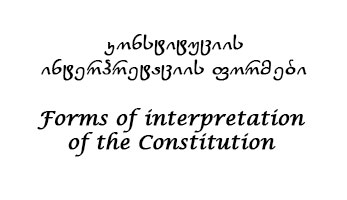
Legislation and particularly the constitution have to being interpreted not only by the sides of the process but also by all members of the group of pluralists and democrats, according to this thesis. The thing is that it better be democratic and critical society to have their own opportunity to interpretate the law. Based to this, constitution is an open tool of integration.
When the case goes to the court, especially to the constitutional court, parties have already had law interpreted and already have their own position. The appellant already knows and makes an interpretation violating a norm, that have affected his interests. The court has to check if this interpretation is correct. Positions and interpretations of the law by parties are different. The judge makes an explanation of the law. He/she is doing this through juridical tools to prove that his decision is fair. Interpreting the constitution is a complex process, where sometimes, established scopes could be demolished.
“Interpretation” has different meanings in law. Therefore, it is important to explain “Interpretation” by itself. Here is how Aharon Barak explains “Interpretation”: Juridical interpretation is a rational activity, which gives notion to the juridical text. The main demand is rationality. Interpretation is an intellectual activity, that interests normative origins throughout the text. Is the text useful? That is the question “Interpretation” has to answer. This process is based on the assumption that there is a useful juridical text. The main thing is what meaning should be given to the text. Interpretation forms the “normative” content. The text that is the subject of interpretation can be general (constitution) or individual (such as a contract or a will). It can be written (like a written constitution) or oral (like an oral will or contract that is implied by force of fact). Under the word text there is not only meaning of written text. For the purpose of the “Interpretation”, all the activities that form norms are text. But constitution is not just a norm, it is supernormal. Constitution is a juridical text which establishes legal norms. Therefore, it should be interpreted in a different way, and not the way other legal texts are interpreted. Constitution stands on the top of the hierarchy of positive law. It forms the nature and strives of society in the language that this or that people spoke at the time of its creation. Although, language of constitution, in general, is characterized by some ambiguity and uncertainty. One of the reasons of it is that, constitution has responsibility to ensure national consent and to ensure this kind of consent high level of abstraction is needed. In this way, constitution establishes political views and social values of the nation and its purposes, commitments and trends as well. Textualism and originalism are the most common forms of explanation of the Constitution and its interpretation.
Textualism is a kind of juridical interpretation which is focused on the context of the text of juridical document. Textualism emphasizes how could be understood the context of constitution in that era when it was ratified. Textualists usually believe that text have an objective notion and when they derive meaning from the text they are not concerned about the ideas of ratifiers and creators of constitution or its additions. They are not concerned about the practical consequences of decisions, in opposite, they doubt the acts of revision and refinement of the text of constitution by the court.
Along with other methods of interpretation, justice is often based on text. Court, first of all, look into the text before consider any other sources, to сlear away any indistinctness in it or to answer fundamental issues of constitutional justice that are not in the text. Proponents of textualism point out that the simplicity and transparency of such an approach, based only on objectively understood linguistic meaning, is independent of ideology and politics. They claim that textualism not allows judges to make decisions based on their own views. They also claim that textualism supports democratic values since it is based on words of constitution that are accepted by people, in spite of what was opinion of individual judges.
Opponents of textualism believe that judges and other interpreters have the right to ascribe different meanings to the text of the Constitution. In addition, opponents argue that it is not desirable for judges to have the opportunity to consider values that are not specifically contained in the text: moral words, practical consequences, structural relations or opinions.
Originalism – According to originalist approach notion of constitution must be understood like it was understood by at least certain segment of population, in the era of its foundation. Although this method is called Originalism, constitutionalists couldn’t manage to make an agreement about what does it mean for judges to take this methodology for the construction of constitution.
The disagreement primarily concerns the sources that scholars should consider in determining the exact meaning of the Constitution. Originalists, in general, agree with each other in fact that in the era of foundation, constitution had objectively identifiable or public notion, that hasn’t change over time and the task for judges and justice is to reconstruct this initial, original notion.
For a long time, some well-known scholars (e.g. Robert Bork) have argued that when interpreting the Constitution, we must follow to original idea by which constitution was drafted and ratified in order to determine what the people wanted it to say. According to this view, the original idea can be found in non-textual sources. Originalists seek the original public opinion of the Constitution. This method considers obvious opinion of the text of constitution as it should be understood by general public, society, civilians or s it was understood by an ordinary, common-sense person. This method has much in common with textualism, but it is not the same. The original public sense approach is not based on the text alone, but on the public understanding of the text, sense as a broader guiding principle.
Supporters of the method of originalism also claim that this approach limits juridical discretion, not allows judges to make decision based on their political views.
In this regard, the “conservative originalism” of the American judge Antonin Scalia is interesting, who believes that the judge should base his decision on the original meaning of the Constitution.
On the other hand, critics of originalism claim that originalists, in fact, construct the original sense themselves. of the people who drafted the constitution and ratified it. According to critics, originalism is a flawed position, because the contemporaries of the constitution could not take into account modern situations. e.g. Originalism cannot protect the rights of minorities because they did not have the same rights at the time of its founding as they do today.





